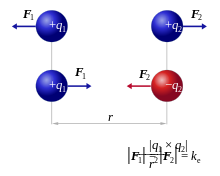Dlí Coulomb
Is dlí turgnamhach fisice é Dlí Coulomb, [1] nó Dlí an Chearnfhaid Inbhéartaigh Coulomb, a chainníochtaíonn ar an méid an fhórsa idir dhá cháithnín atá luchtaithe go leictreach agus nach bhfuil ag bogadh. De ghnáth tugtar fórsa leictreastatach nó fórsa Coulomb ar an bhfórsa leictreach idir comhlachtaí luchtaithe atá ar fos.[2] D'aimsigh an fisiceoir Francach Charles-Augustin de Coulomb an dlí den chéad uair sa bhliain 1785, agus uaidh an t-ainm. Bhí dlí Coulomb riachtanach d’fhorbairt theoiric an leictreamaighnéadais, b’fhéidir fiú a phointe tosaigh, toisc go raibh sé indéanta méid an luchta leictreachais a phlé go ciallmhar.[3]

Deirtear sa dlí go bhfuil méid fhórsa leictreastatach an aomacháin nó an éartha idir dhá phonclucht comhréireach go díreach le táirge méideanna na luchtanna agus comhréireach go hinbhéartach leis an fhad cearnaithe eatarthu.[4]
Naisc sheachtracha
cuir in eagarTagairtí
cuir in eagar- ↑ Huray, Paul G., 1941- (2010). "Maxwell's equations": 8, 57. Hoboken, N.J.: Wiley. OCLC 739118459.
- ↑ "Fundamentals of Physics" (2013): 609, 611. John Wiley & Sons.
- ↑ "The development of the concept of electric charge: Electricity from the Greeks to Coulomb" (1954). Cambridge, MA: Harvard University Press.
- ↑ Coulomb (1785) "Premier mémoire sur l’électricité et le magnétisme," Histoire de l’Académie Royale des Sciences, pp. 569–577 — Coulomb studied the repulsive force between bodies having electrical charges of the same sign:
Il résulte donc de ces trois essais, que l'action répulsive que les deux balles électrifées de la même nature d'électricité exercent l'une sur l'autre, suit la raison inverse du carré des distances. Translation: It follows therefore from these three tests, that the repulsive force that the two balls — [that were] electrified with the same kind of electricity — exert on each other, follows the inverse proportion of the square of the distance.
— Coulomb (1785b) "Second mémoire sur l’électricité et le magnétisme," Histoire de l’Académie Royale des Sciences, pages 578–611Coulomb also showed that oppositely charged bodies obey an inverse-square law of attraction.
